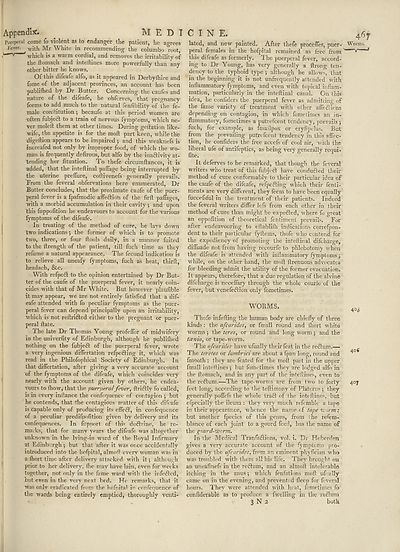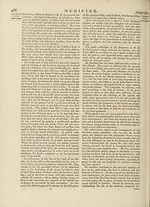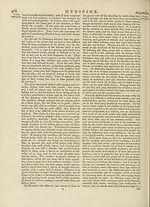Encyclopaedia Britannica, or, a Dictionary of arts, sciences, and miscellaneous literature : enlarged and improved. Illustrated with nearly six hundred engravings > Volume 13, MAT-MIC
(509) Page 467
Download files
Complete book:
Individual page:
Thumbnail gallery: Grid view | List view

Append!*. M E D T
Puerperal come fo violent as to endanger tlie patient, he agrees
Fever- with Mr White in recommending the columbo root
^ , J which is a warm cordial, and removes the irritability of
the ftomach and inteftines more powerfully than any
other bitter he knows.
Of this difeafe alfo, as it appeared in Derbyfhire and
fome of the adjacent provinces, an account has been
publilhed by Dr Butter. Concerning the caufes and
nature of the difeafe, he obferves, that pregnancy
feems to add much to the natural fenlibility of the fe¬
male conditution •, becaufe at this period women are
nften fubjeft to a train of nervous fymp'oms, which ne¬
ver moleft them at other times. During geftation like-
wife, the appetite is for the moft part keen, while the
digeftion appears to be impaired ; and this weaknefs is
increafcd not only by improper food, of which the wo¬
man is frequently defirous, but alfo by the inaftivity at¬
tending her fituation. To thefe circumftances, it is
added, that the inteftinal paffage being interrupted by
the uterine preffure, coftivenefs generally prevails.
From the feveral obfervations here enumerated, Dr
Butter concludes, that the proximate caufe of the puer¬
peral fever is a fpafmodic affe&ion of the firft paflages,
with a morbid accumulation in their cavity •, and upon
this fuppofition he endeavours to account for the various
fymptoms of the difeafe.
In treating of the method of cure, he lays down
two indications •, the former of which is to promote
two, three, or four ftools daily, in a manner fuited
to the llrength of the patient, till fuch time as they
refume a natural appearance. The fecond indication is
to relieve all uneafy fymptoms, fuch as heat, thirft,
headach, &c.
With refpedt to the opinion entertained by Dr But¬
ter of the caufe of the puerperal fever, it nearly coin¬
cides with that of Mr White. But however plaulible
it may appear, we are not entirely fatisfied that a dif¬
eafe attended with fo peculiar fymptoms as the puer¬
peral fever can depend principally upon an irritability,
which is not reftrifted either to the pregnant or puer¬
peral ftate.
The late Dr Thomas Voung profeflbf of midwifery
in the univerfity of Edinburgh, although he publilhed
nothing on the fubjefl of the puerperal fever, wrote
a very ingenious diflfertation refpe&ing it, which was
read in the Philofophical Society of Edinburgh. In
that dilfertation, after giving a very accurate account
of the fymptoms of the difeafe, which coincides very
nearly with the account given by others, he endea¬
vours to fliow, that the 'puerperalfever, ftr’nflly fo called,
is in every intlance the confequence of contagion ; but
he contends, that *he contagious matter of this difeafe
is capable only of producing its effe£f, in confequence
of a peculiar predifpolition given by delivery and its
confequenees. In fupport of this doftrine, he re¬
marks, that for many years the difeafe was altogether
unknown in the lying-in -ward of the Royal Infirmary
at Edinb rgh ; but that after it was once accidentally
introduced into the hofpital, almoff every woman was in
a Ihort time after delivery attacked with it; although
prior to her delivery, (lie may have lain, even for weeks
together, not only in the fame ward with the infefled,
but even in the very next bed. He remarks, that it
was onlv eradicated from the hofnita.l m confequence of
the wards being entirely emptied, thoroughly venti-
C I N E.
lated, and new painted. After thefe procefles, puer¬
peral females in the hofpital remained as free from
this difeafe as formerly. 1 he puerperal fever, accord¬
ing to Dr Young, has very generally a ftrong ten¬
dency to the typhoid type ; although he allows, that
in the beginning it is not unfrequently attended with
inflammatory fymptoms, and even with topical inflam¬
mation, particularly in the inteftinal canal. On this
idea, he conliders the puerperal fever as admitting of
the fame variety of treatment with oilier affedih ns
depending on contagion, in which fometimes an in¬
flammatory, fometimes a putrefcent tendency, prevails j
fuch, for example, as fmailpox or eryfipelas. But
from the prevailing putrefcent tendency in this affec¬
tion, he confiders the free accefs of cool air, with the
liberal ufe of antifeptics, as being very generally requi»
fite.
It deferves to be remarked, that though the feveral
writers who treat of this fubjedl have conducted their
method of cure conformably to their particular idea of
the caufe of the difeafe, refpefting which their fenti-
ments are very different, they feem to have been equally
fuccefsful in the treatment of their patients. Indeed
the feveral writers differ lefs from each other in their
method of cure than might be expected, where fo great
an oppofition of theoretical fentiment prevails. For
after endeavouring to eftablifti indications correfpon-
dent to their particular fyftems, thofe who contend for
the expediency of promoting the inteftinal difeharge,
diffuade not from having recourfe to phlebotomy when
the difeafe is attended with inflammatory fymptoms $
while, on the other hand, the moft ftrenuous advocates
for bleeding admit the utility of the former evacuation.
It appears, therefore, that a due regulation of the alvine
difeharge is neceffary through the whole courle of the
fever, but venefedtion only fometimes.
WORMS.
Thofe infefling the human body are chiefly of three
kinds : the afearides, or fmall round and flrort white
worms; the teres, or round and long worm j and the
teen in, or tape-worm.
The afearides have ufually their feat in the redtum.—
The teretes or lumbrici are about a fpan long, round and
fmooth : they are feated for the moft part in the upper
fmall inteftines; but fometimes they are lodged alfo in
the ftomach, and in any part of the inteftines, even to
the redrum.—The. tape-worms are from two to forty
feet long, according to t he teftimony of Platerus ; they
generally poffefs the whole trad! of the inteftines, but
efpecially the ileum : they very much referable a tape
in their appearance, whence the name of tape worm;
but another fpecies of this genus, from he refera-
blance of each joint to a gourd feed, has the name of
the gourd-worm.
In the Medical Tranfadtions, vol. i. Dr Heberden
gives a very accurate account of the fymptoms pro¬
duced by the cfcandes, from an eminent phyfician who
was troubled with them all his life. They brought on
an uneafinefs in the redtum, and an almoft intolerable
itching in the anus*, which fenfations moft ufuslly
came on in the evening, and prevented fleep for feveral
hours. They were attended with heat, fometimes fo
confiderable as to produce a fwelling in the redtum
3 N 2 both.
Puerperal come fo violent as to endanger tlie patient, he agrees
Fever- with Mr White in recommending the columbo root
^ , J which is a warm cordial, and removes the irritability of
the ftomach and inteftines more powerfully than any
other bitter he knows.
Of this difeafe alfo, as it appeared in Derbyfhire and
fome of the adjacent provinces, an account has been
publilhed by Dr Butter. Concerning the caufes and
nature of the difeafe, he obferves, that pregnancy
feems to add much to the natural fenlibility of the fe¬
male conditution •, becaufe at this period women are
nften fubjeft to a train of nervous fymp'oms, which ne¬
ver moleft them at other times. During geftation like-
wife, the appetite is for the moft part keen, while the
digeftion appears to be impaired ; and this weaknefs is
increafcd not only by improper food, of which the wo¬
man is frequently defirous, but alfo by the inaftivity at¬
tending her fituation. To thefe circumftances, it is
added, that the inteftinal paffage being interrupted by
the uterine preffure, coftivenefs generally prevails.
From the feveral obfervations here enumerated, Dr
Butter concludes, that the proximate caufe of the puer¬
peral fever is a fpafmodic affe&ion of the firft paflages,
with a morbid accumulation in their cavity •, and upon
this fuppofition he endeavours to account for the various
fymptoms of the difeafe.
In treating of the method of cure, he lays down
two indications •, the former of which is to promote
two, three, or four ftools daily, in a manner fuited
to the llrength of the patient, till fuch time as they
refume a natural appearance. The fecond indication is
to relieve all uneafy fymptoms, fuch as heat, thirft,
headach, &c.
With refpedt to the opinion entertained by Dr But¬
ter of the caufe of the puerperal fever, it nearly coin¬
cides with that of Mr White. But however plaulible
it may appear, we are not entirely fatisfied that a dif¬
eafe attended with fo peculiar fymptoms as the puer¬
peral fever can depend principally upon an irritability,
which is not reftrifted either to the pregnant or puer¬
peral ftate.
The late Dr Thomas Voung profeflbf of midwifery
in the univerfity of Edinburgh, although he publilhed
nothing on the fubjefl of the puerperal fever, wrote
a very ingenious diflfertation refpe&ing it, which was
read in the Philofophical Society of Edinburgh. In
that dilfertation, after giving a very accurate account
of the fymptoms of the difeafe, which coincides very
nearly with the account given by others, he endea¬
vours to fliow, that the 'puerperalfever, ftr’nflly fo called,
is in every intlance the confequence of contagion ; but
he contends, that *he contagious matter of this difeafe
is capable only of producing its effe£f, in confequence
of a peculiar predifpolition given by delivery and its
confequenees. In fupport of this doftrine, he re¬
marks, that for many years the difeafe was altogether
unknown in the lying-in -ward of the Royal Infirmary
at Edinb rgh ; but that after it was once accidentally
introduced into the hofpital, almoff every woman was in
a Ihort time after delivery attacked with it; although
prior to her delivery, (lie may have lain, even for weeks
together, not only in the fame ward with the infefled,
but even in the very next bed. He remarks, that it
was onlv eradicated from the hofnita.l m confequence of
the wards being entirely emptied, thoroughly venti-
C I N E.
lated, and new painted. After thefe procefles, puer¬
peral females in the hofpital remained as free from
this difeafe as formerly. 1 he puerperal fever, accord¬
ing to Dr Young, has very generally a ftrong ten¬
dency to the typhoid type ; although he allows, that
in the beginning it is not unfrequently attended with
inflammatory fymptoms, and even with topical inflam¬
mation, particularly in the inteftinal canal. On this
idea, he conliders the puerperal fever as admitting of
the fame variety of treatment with oilier affedih ns
depending on contagion, in which fometimes an in¬
flammatory, fometimes a putrefcent tendency, prevails j
fuch, for example, as fmailpox or eryfipelas. But
from the prevailing putrefcent tendency in this affec¬
tion, he confiders the free accefs of cool air, with the
liberal ufe of antifeptics, as being very generally requi»
fite.
It deferves to be remarked, that though the feveral
writers who treat of this fubjedl have conducted their
method of cure conformably to their particular idea of
the caufe of the difeafe, refpefting which their fenti-
ments are very different, they feem to have been equally
fuccefsful in the treatment of their patients. Indeed
the feveral writers differ lefs from each other in their
method of cure than might be expected, where fo great
an oppofition of theoretical fentiment prevails. For
after endeavouring to eftablifti indications correfpon-
dent to their particular fyftems, thofe who contend for
the expediency of promoting the inteftinal difeharge,
diffuade not from having recourfe to phlebotomy when
the difeafe is attended with inflammatory fymptoms $
while, on the other hand, the moft ftrenuous advocates
for bleeding admit the utility of the former evacuation.
It appears, therefore, that a due regulation of the alvine
difeharge is neceffary through the whole courle of the
fever, but venefedtion only fometimes.
WORMS.
Thofe infefling the human body are chiefly of three
kinds : the afearides, or fmall round and flrort white
worms; the teres, or round and long worm j and the
teen in, or tape-worm.
The afearides have ufually their feat in the redtum.—
The teretes or lumbrici are about a fpan long, round and
fmooth : they are feated for the moft part in the upper
fmall inteftines; but fometimes they are lodged alfo in
the ftomach, and in any part of the inteftines, even to
the redrum.—The. tape-worms are from two to forty
feet long, according to t he teftimony of Platerus ; they
generally poffefs the whole trad! of the inteftines, but
efpecially the ileum : they very much referable a tape
in their appearance, whence the name of tape worm;
but another fpecies of this genus, from he refera-
blance of each joint to a gourd feed, has the name of
the gourd-worm.
In the Medical Tranfadtions, vol. i. Dr Heberden
gives a very accurate account of the fymptoms pro¬
duced by the cfcandes, from an eminent phyfician who
was troubled with them all his life. They brought on
an uneafinefs in the redtum, and an almoft intolerable
itching in the anus*, which fenfations moft ufuslly
came on in the evening, and prevented fleep for feveral
hours. They were attended with heat, fometimes fo
confiderable as to produce a fwelling in the redtum
3 N 2 both.
Set display mode to:
![]() Universal Viewer |
Universal Viewer | ![]() Mirador |
Large image | Transcription
Mirador |
Large image | Transcription
Images and transcriptions on this page, including medium image downloads, may be used under the Creative Commons Attribution 4.0 International Licence unless otherwise stated. ![]()
| Permanent URL | https://digital.nls.uk/192667779 |
|---|
| Attribution and copyright: |
|
|---|
| Description | Ten editions of 'Encyclopaedia Britannica', issued from 1768-1903, in 231 volumes. Originally issued in 100 weekly parts (3 volumes) between 1768 and 1771 by publishers: Colin Macfarquhar and Andrew Bell (Edinburgh); editor: William Smellie: engraver: Andrew Bell. Expanded editions in the 19th century featured more volumes and contributions from leading experts in their fields. Managed and published in Edinburgh up to the 9th edition (25 volumes, from 1875-1889); the 10th edition (1902-1903) re-issued the 9th edition, with 11 supplementary volumes. |
|---|---|
| Additional NLS resources: |
|

